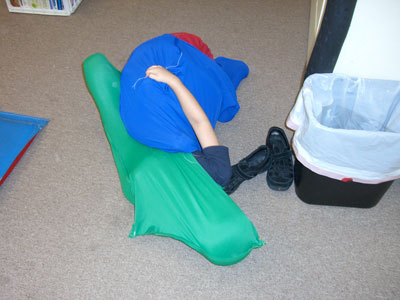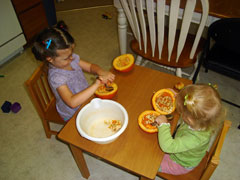Creating a Home Sensory Diet

Ideas for Creating a Sensory Diet at Home
If you feel that some of us are a bit reluctant to go too far explaining our home sensory diets... you are right!
There is a caution among us between sharing what we do with our kids, and what you need to do with your kids. We do feel a certain responsibility, to first: Do No Harm. And that is where the reluctance comes from.
When we do talk about this, we dinosaurs, are so very careful to say, over and over, "talk to your own OT, about what activities would be right for your child." Just because this activity may be calming to mine, does not mean it will work for yours.
The dilemma arises when there are parents who have OT's that will not help them discover the appropriate activities specifically for their children, or those parents among us who cannot get appropriate therapy due to location, or finances. Some only get school based therapy, which may be more geared to how SPD impacts a child in the educational setting, but not necessarily inclusive of all the occupations of a child.
(Also, some schools cannot provide this type of therapy with the frequency necessary due to large caseloads, limited time, and that the child's sensory issues may not be impacting him enough within the classroom to warrant treatment from an educational standpoint. But, it is something we are working on improving.)
Will some parents try to do brushing, or deep pressure without an OT overseeing them, and actually harm their child? We hope not, please don't, and again, the warnings from us constantly... take care, ask a professional, don't take our word for it.
So what to do? To deny information is not right. That is what we are here for after all. So we tread carefully, offering information with warnings and cautions. Many parents who are new to this type of therapy misunderstand greatly, and think a sensory diet is certain kinds of foods, or that the only kinds of activities that can help are those done in the OT clinic. Not true.
So, in an effort to promote clarity and understanding, but not to suggest that our own sensory diets will necessarily be right for any one else's child, we will discuss this. And so we do. The best and only expert on each of our children is the parent. You know what kinds of behaviors you are seeing. And really, we end up combining what our OT's do at the clinic with our own observations of what is helpful at home. The parent must become the detective with their child.
Creating the Sensory Diet
FIRST: Study, and write down through the course of a few days, what behaviors you are seeing. Many of you have already written them out, in an attempt to tell us in one of our support groups, what's happening at home.
You may have said things like:
He spins through the house, crashing into everything!
The Sensory Diet solution is: Give him something safe to spin and crash on.
She mouths everything in sight!
The Sensory Diet solution is: Give her more appropriate things to mouth, increase oral
activities.
He jumps all over the furniture!
The Sensory Diet solution is: Give him a safe space and something to jump on. (I actually
bought a yard sale couch for my son to jump on, and put huge pillows all around it, prior to
our trampoline)
See what I am saying?
Each child is so very different, and has different needs for specific activities. But if you look closely at what they are doing, they are telling you, in the only way they know how (with their behaviors) what they are needing. Take what they already do and make it safer. More appropriate. That's the beginning of your sensory diet.
Give them what they are needing, in better, healthier ways. Redirect them to a safer way to get the same input. And remember, these are kids, so make it fun! They'll feel better for being able to do these things for as long as they need to. And you'll be happier not hollering "Get off my couch!"
Ask your therapist, if you have one. Say: "You say he has vestibular (low muscle tone, visual-spatial, tactile, etc.) problems. Can you give me a few examples of what to do at home." And start building from there.
Some of our diets? Are worked right into our normal day. Like carrying the laundry basket or bringing in the groceries. Measuring out ingredients when we are cooking. Pulling a sibling in a wagon. Swinging. Exercising with Mom. Moving and dancing to the Songs for Sensational Kids: The Wiggly Scarecrow .
Offer different activities throughout the day. Keep in mind, you can help them through all their senses:
- Is a certain candle soothing to your child? Another alerting?
- Does your child blissfully sit in front of the fish tank, or watch the flames in the fireplace?
- Is a slow walk at sunset calming to them?
- Do they love to be hugged tight, or rolled up in their towel after their bath?
- Does certain music wind them up? And other music make them sleepy or quiet?
- Is white noise calming or irritating?
This is exactly what we all had to figure out, and go on figuring out as time passes and their needs change.

Then, you can also work on specific issues, by adding more sensory exercises in those areas. So, we can give you a picture of a day in the life of ours, but it would be for the moment, and always changing, depending on the stresses in their lives, and what particular issues we are working on right now, today.
But the most important thing, I think, is examining the behaviors and issues of your own child and beginning to work on the ways to add or decrease input that directly helps your child.